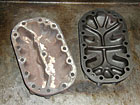
Greening a building can be achieved by carrying out part of “reduce, reuse, recycle.” One way is to utilize remanufactured compressors in the HVAC sector.
The focus these days is on green buildings and building edifices in a green way. The movement began with new buildings and has expanded to embrace making existing buildings green as well. Greening a building can be achieved by carrying out part of the old environmental adage “reduce, reuse, recycle.”
One way to reduce and reuse in the HVACR sector is to utilize remanufactured compressors. According to the study “Engineering Reduced Greenhouse Gas Production: A Remanufacturing Solution,” by Dr. Wahidul Biswas and Prof. Micele Rosano, “Remanufacturing can potentially significantly reduce the carbon footprint associated with the production of a new (OEM) 20-hp (or 15-kW) compressor by between 89 to 93 percent, or 1,473 kg and 1,415 kg respectively, when 99 percent and 96.5 percent of the total parts on basis of weight are reused in remanufacturing a compressor.”
In addition to reducing the carbon footprint, remanufactured compressors also save financial green. Richard Staiano, president of National Compressor Exchange Inc., said, “The manufacturers sell new compressors outright, not on exchange (no core due), and that drives the price up.”
National Compressor also furnishes “compressors which are no longer built by the OEM or considered obsolete. For this reason, National continues to offer these models, which enables contractors to be able to repair systems at a much lower cost, even after compressors are deemed not available by the OEM,” stated Staiano. And if customers want the same compressor back, the company can completely remanufacture their compressor, he continued.
Other benefits that Staiano said National the company offers with compressor remanufacturing is quick availability and matching the nomenclature, so “the installer does not have to make changes to match the replacement to the existing design.”
THEN AND NOW
The company specializes in remanufacturing industrial and commercial compressors for refrigeration, air conditioning, and transportation. On a daily basis, the company works on reciprocating compressors and screws on its production lines.Staiano claims there are three basic types of compressor failures: electrically bad (grounded), overheated, or mechanically scrambled. He also commented that many electrical failures start as mechanical problems.
The company sells only to contractors and industrials with onsite ACR technicians, and this policy hasn’t changed since the company was founded in 1978, said Staiano.
A few things have changed at National since that time. One is the range and type of compressors the company remanufactures. Another change is the techniques (type of factory equipment and testing instruments), which have been greatly enhanced by state-of-the-art technology. Its “range of compressor is changing all the time, so much so that we have created a full time R&D department to explore how to remanufacture new models and enhance the production procedure on the compressors we are building,” said Staiano.
Also, the way the company processes compressors has changed over the last 32 years. In one example, the company used to utilize “chemicals, alkaline baths, fluoric acid for metal brightening, and other liquids to clean parts,” said Staiano. Today it uses no chemicals in any of its various remanufacturing steps.
As an example, the “test process is all computerized by a system [Staiano] created, designed, and had built by computer engineers, naming it the auto-comparison test system (ACT).” In another example, for compressor leak detection, most other remanufacturers and rebuilders still use a water tank, filling it with nitrogen and dipping compressors into the tank under pressure, much like checking a tire for a leak.
The company now uses “a helium leak detection system, which we feel is essential for leak checking due to the many new blends of refrigerants and new materials in the gaskets,” remarked Staiano. The blends are more susceptible to leak over the old refrigerants, and the gasket materials have changed, making them more difficult to seal.

A compressor head before (left) and after (right) it has been cleaned.
THE PROCESS
To ensure that customers get a reliable compressor for their application, the company’s remanufacturing process has seven steps to it:1. Disassembly.All internal and external parts, including rods, pistons, crankshafts, bearings, and liners, are totally removed from compressor bodies. This also includes fittings, plates, and all electrical components, leaving the compressor casting completely stripped.
Immediately after disassembly, a complete parts list is made of all internal parts needed for remanufacturing the compressor. The compressor bodies and parts are dispatched to the cleaning department.
2. Cleaning.All cast iron components and bodies are burned in an air oven for degreasing. Once all oils and metal particles are burned, the castings are placed in a shot peen machine, and charged with specially manufactured soft shot to clean the castings to their original manufactured appearance. This process is environmentally safe and does not use chemicals that are harmful to the environment.
Quality control (QC) checks are made of all castings and surfaces to ensure no particles remain, and that all surfaces meet the required finish to seal. Surfaces with any marks or scratches are put on a lapping machine or resurfacing machines. The castings are measured and marked for machine shop finishing work.
3. Subassembly.After cleaning, all internal parts are sent to various departments to further check specifications and QC approving parts for assembly. Terminal plates are completely disassembled, cleaned, resurfaced, then assembled with all new parts. They are torqued using a preset tool, which automatically stops at the exact inch/pounds required by the manufacturer.
The company has a fully equipped electrical stator rewind department with a computerized winding machine. On large stators, the company VPIs (vacuum pressure impregnates) them to ensure full varnish coating. This reduces the chance of slot burn.
ASSEMBLY PREPARATION: The compressor castings go through the machining department for cylinder sleeving, line boring of main bearings, and on the bridge port to set the valve finger stoppers.
The finished crankshaft and castings are put on a conveyor for QC inspection and approval. All subassembly parts for each model are laid out on assembly trays with qualified crankshafts. All piston rings, valves, bearings, internal reliefs, oil pumps, and wrist pins are replaced with new parts.

The auto-comparison test system (ACT).
For screw compressors, digital depth gauges and backlash tooling for measuring clearance of the male and female rotors are critical in this process. This also requires special tooling for each make and size of rotor. Every model the company works on has specialized tooling.
5. Assembly.RECIPROCATING COMPRESSORS: Directly from subassembly/QC, the compressors are ready for assembly and all internal parts are QC hand-stamped along with the compressor casting. All cylinders are QC-approved and recorded on tolerance sheets called tracer papers, which travel with each compressor throughout the process. The information required for the assemblers is now at their fingertips. Torque specifications, tolerances, and clearances pertaining to each assembly are checked. All the instruments meet the ISO Certification program.
SCREW COMPRESSORS: The company remanufactures screw compressors for some leading manufacturers and manufactures screws of all makes and models. It takes a large amount of specialized tooling that is created in the machine department by the tool and dye maker before National Compressor Exchange can begin assembly of the screw line. All of the assemblies meet OEM specifications.
HERMETIC COMPRESSOR REMANUFACTURING: The company has a fully equipped welding department that is skilled in submerged arc welding, tig, and argon gas welding. It builds Trane 20- to 30-ton hermetic cans. Staiano said it holds a contract to remanufacture Dunham Bush/Hartford Compressor’s MSCs, large-tonnage (125-200-ton) hermetic compressors. Staiano stated the full welding department has opened new opportunities because of diversity in its ability to weld many types of metals and the use of this department for exploring future hermetically sealed compressor production.
6. Testing and QC.After resurfacing on the Blanchard, the valve plates’ thicknesses are measured on a true stone using a dial indicator and micrometer. It then goes to the valve plate assembly table. All prequalified internal parts are matched to each compressor casting, and crankshafts are thoroughly checked, going through all tolerances and laid out with new parts on trays for assembly. The final step for QC is to scrutinize specifications, stamping the parts with the QC approval code. Once completed, the compressor is forwarded to the Assembly area.
Throughout the process, in all areas of production, employees punch in on a keypad at their department stations. The tracer number and employee number are saved in the system. This ensures complete tracking of the processes through each department and makes certain that no steps are missed. Detailed reports, including the tracer sheets, test sheets, and all departmental test results with all tolerances, are printed and filed with each compressor invoice by customer name.
7. Finished product line-name plating and labeling.The final process before packaging is name plating the compressor. This is accomplished through an integrated series computer connected between the shipping computer and run-test computer.
The shipping computer, which is called WatchDog, analyzes test results on passed compressors, prints name tags, run test results, and all shipping papers assigned to that particular model compressor. To further ensure QC, none of the documents or nametags will print without the computer passing test. The compressor is then moved to packaging and skidding.
Publication date:03/29/2010




